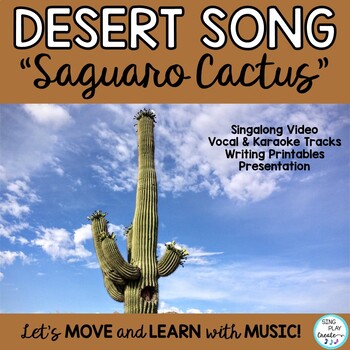Desert Cactus Habitat Sing Along Video Song Writing Activities “Saguaro Cactus”
- Zip
Description
Distance Learning Resource- VIDEO SING ALONG
Desert habitat science lessons are so easy when students sing, read and write about the desert. Three Beat Western style with vocal and karaoke tracks, "Saguaro Cactus". Perfect for elementary classrooms, and music programs.
PREVIEW INCLUDES AUDIO SAMPLE
RESOURCE INCLUDES:
Sing Along Video
Power Point presentation with lyrics
Storybook pages
Mp3 Tracks for Vocal and Accompaniment
Hand Motion Directions
Science Standards Connections
Printable Lyric Sheet students can color
Writing Activities
4 Saguaro Cactus Landscape photos
USE THIS RESOURCE:
HOME SCHOOL
DISTANCE LEARNING
ELA ACTIVITIES
SCIENCE ACTIVITIES
SUMMER CAMPS
INTEGRATED ARTS AND CURRICULUM LESSONS
- The video makes it easy to use during your morning meetings, brain break time and reward activities.
- Combine the song and writing activities with your existing habitat lesson materials.
- Perfect for Pre-K, Kindergarten, First, Second and Third grade Habitat lessons.
- Music Teachers! Add this song to your desert and western music programs.
- Grab the attention of your students by using this song in your science lessons while studying habitats.
- Why not sing the song during your morning meetings and then later during science students will reflect on the song and connect to their lessons even better!
- Use the video in your homeschooling or distance learning classes.
Your students will love learning about desert habitats when they get to sing too!
MUSIC TEACHERS
Try integrating Science and Music together by using this song in your classroom or in a music program. Combine these Desert Songs with some of your favorite western and folk songs for a cross-curricular music program.
LYRIC SAMPLE
“Saguaro cactus, you rule the Sonoran skies.
Saguaro cactus, you are a desert surprise.”
MORE HABITAT LITERACY SONGS AND ACTIVITIES
Desert Habitat Song “Coyote, Coyote”
Desert Habitat Song “It’s Hot in the Desert”
Desert Habitat Song “Saguaro Cactus”
***********************
ABOUT SING PLAY CREATE LLC.
All products and works are copyrighted by Sing Play Create LLC. Buyers may get Free store credit by going to "my purchases" and click on "Provide Feedback". Ratings and helpful feedback are welcomed.
Want a Freebie every month? Subscribe to my Website Newsletter.
QUESTIONS? Please use the "Ask a Question" section of my TpT store. Or, you can email me at sandra@singplaycreate.com
CONNECT WITH ME HERE:
Sing Play Create YouTube Channel
Thanks for stopping by!
Sandra





